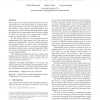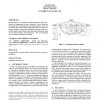MICRO
2012
IEEE
12 years 1 months ago
2012
IEEE
This article presents a general algorithm for transforming sequential imperative programs into parallel data-flow programs. Our algorithm operates on a program dependence graph i...
IJICT
2007
13 years 11 months ago
2007
We propose a parallel algorithm for dynamic slicing of distributed Java programs. Given a distributed Java program, we first construct an intermediate representation in the form o...
SIGSOFT
1994
ACM
14 years 3 months ago
1994
ACM
A dependence model for reverse engineering should treat procedures in a modular fashion and should be fine-grained, distinguishing dependences that are due to different variables....
SCAM
2002
IEEE
14 years 4 months ago
2002
IEEE
Dynamic program slicing is an effective technique for narrowing the errors to the relevant parts of a program when debugging. Given a slicing criterion, the dynamic slice contains...
SCAM
2003
IEEE
14 years 4 months ago
2003
IEEE
The Program Dependence Graph was introduced by Ottenstein and Ottenstein in 1984. It was suggested to be a suitable internal program representation for monolithic programs, for th...
PLDI
2009
ACM
14 years 6 months ago
2009
ACM
We present the first machine-checked correctness proof for information flow control (IFC) based on program dependence graphs (PDGs). IFC based on slicing and PDGs is flow-sensi...
ESSOS
2010
Springer
14 years 8 months ago
2010
Springer
Information flow control systems provide the guarantees that are required in today’s security-relevant systems. While the literature has produced a wealth of techniques to ensur...
SIGSOFT
2003
ACM
15 years 7 days ago
2003
ACM
Program slicing is a technique to identify statements that may influence the computations at other statements. Precise slicing has been shown to be undecidable for concurrent prog...


